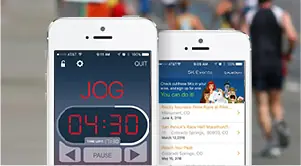For the geeks out there, yes, you are training fast-twitch muscles, but the slow-twitch muscles are still benefitting. And in fact, the more you recruit and train those fast-twitch muscle fibers, the more they begin to take on the characteristics of slow-twitch muscle fibers. And with an effort such as the marathon being all slow twitch, the more muscles you have to recruit come race day, the better.
More: A Runner's Building Blocks
Fast First, Mileage Can Wait
Another plus for a 10K training program to kick off your season, or build fitness in the off-season, is the fact that high mileage isn't required. Long training runs might fill you up with wonderful endorphins, but they also beat you down. The consistent pounding, week after week, eventually dulls your fitness and hampers your ability do the speed work normally associated with 10K training.
Over the course of an eight-week 10K training program, you can see upwards of a 1- to 3-minute improvement. That's as much as 30 seconds per mile on your functional threshold pace! When you begin to do your longer marathon-focused mileage, your easy pace will also see similar improvements.
More: 4 Tips for Your 10K Training
Consider it an alternative to the constant mileage of marathon training. A 10K program will provide a welcome respite from the traditional mileage-oriented training programs. Done properly, you'll not only get a mental break, but also a physical boost.
Speed vs. Distance: the Injury Conundrum
The biggest concern about speedwork is the potential risk for injury. There's no doubt that running with intensity poses a risk, but experience has shown that runners have as much to fear from consistent runs longer than an hour as they do from the shorter, harder workouts—if not more.
More: Your Marathon Speedwork Plan for Success
This is especially true when you consider a program that uses the results of your own 10K time as a guide for determining your training paces. Train this way and you will only run as fast as your body says it can, not as fast as some evil taskmaster of a program or coach says you should.
Faster running does have its up side as well. In addition to recruiting those fast-twitch muscle fibers, you'll be working at a faster cadence, which can improve your running form. And let's not forget the rush of flying down the road.
More: 6 Tips to Improve Your Running Form
When to Pull the Marathon Trigger
Before you register for the next available marathon, keep a few things in mind. You'll still need to follow a quality training program for at least 12 weeks before your race, if not longer. And you'll ideally have been running pain- and injury-free for a few months prior.
More: The Couch to Marathon Transformation
Consider the 10K to be your ticket to year-round fitness and speed. It's safe enough to train and race repeatedly, and it's close enough to its marathon cousin to be part of the running foundation that sets you up to achieve your long-distance running goals as well.
More: Should You Race a Half Marathon Before a Marathon?
 Sign up for your next 10K or marathon race.
Sign up for your next 10K or marathon race. - 2
- of
- 2










Discuss This Article